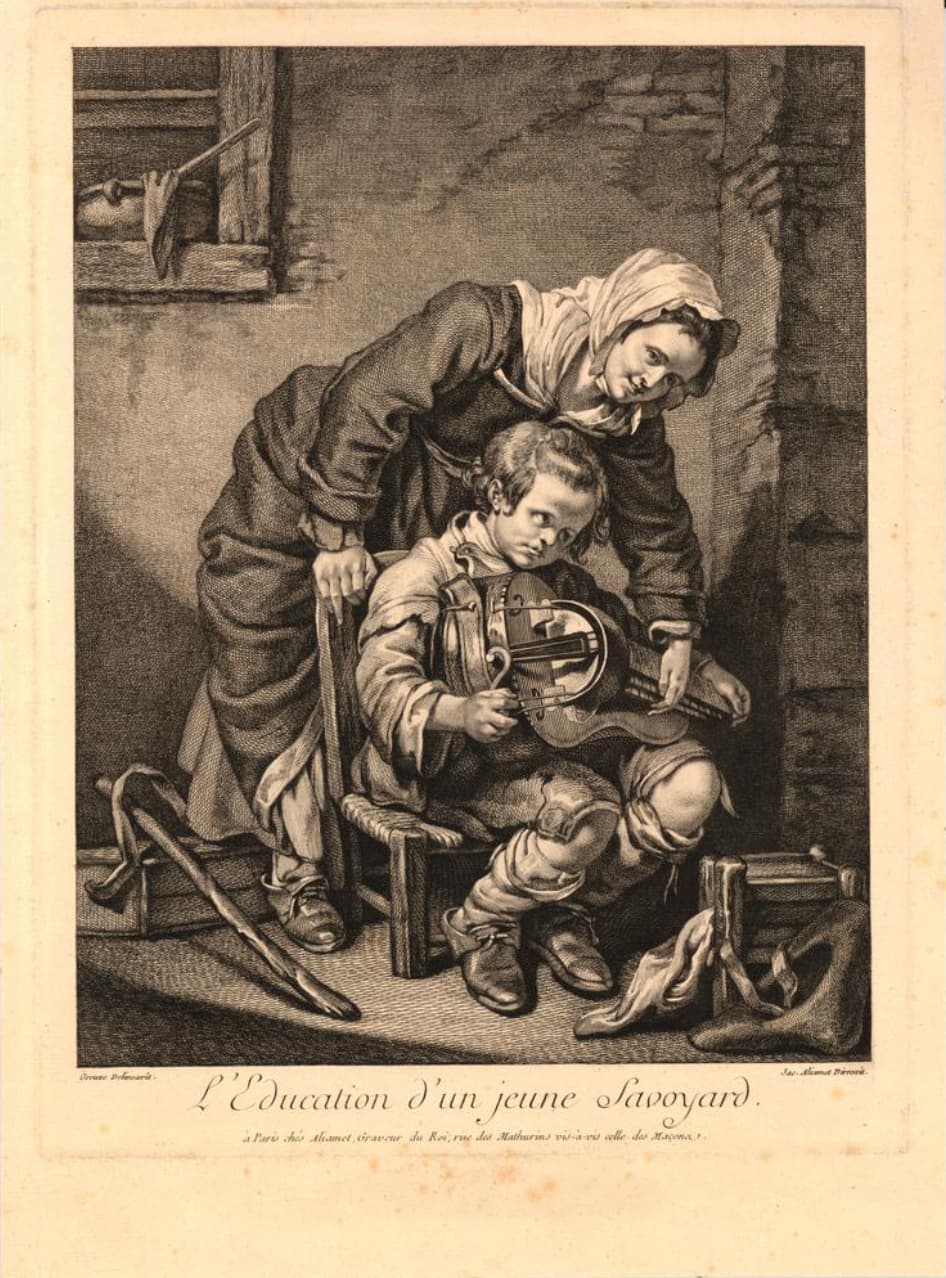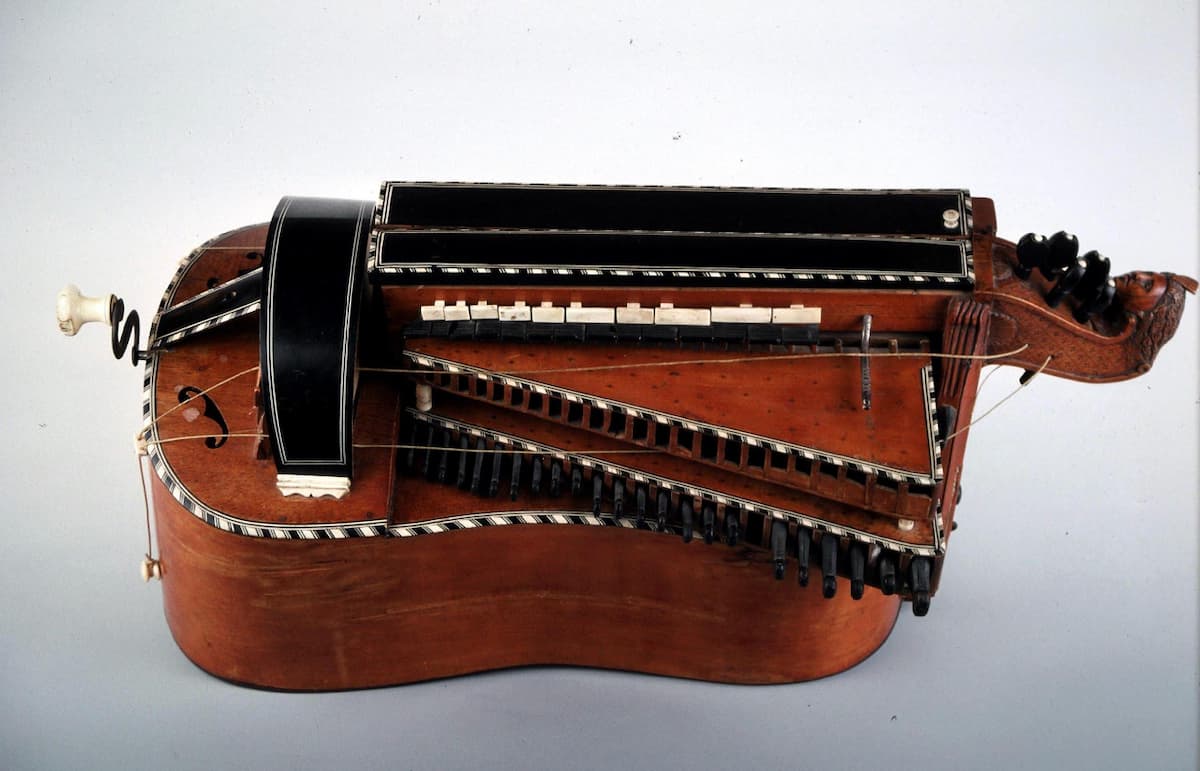The hurdy gurdy is a musical instrument that dates back to medieval times, across history it had its ups and downs in popularity, but one of the golden eras was the Baroque period, specially the XVIII century, but… What exactly is a Hurdy Gurdy? Let’s take a moment to enjoy a video of one of the greatest living exponents in baroque music, the great Tobie Miller.
Jean-Baptiste Dupuits : Pièces de Caractères, Ensemble Danguy Tobie Miller Vielle Baroque
What is a hurdy gurdy?
As you have seen in the video, the instrument consists of a wooden box, a crank, and strings that are vibrated by a wheel, in catalonia we call it Viola de Roda “Wheel Fiddle”, I guess this name makes a lot of sense! Coming back to strings, we have three types:
1. drones which provide the low sound in the back.
2. melody strings which are fretted by tangents using the keys.
3. trompettes, which could be described as alto drones which are connected to a buzzing bridge, this is one of the main features that make the instrument so unique, we get the buzzes by accelerating the revolution of the wheel.
While it was originally used as an accompanying instrument, the hurdy-gurdy found its way into Baroque music in the court of Queen Marie Leszcynska (wife of Louis XV) and was used by composers such as Vivaldi, Chedeville, Baton, and Corrette among others.
From the Poor Class to the Aristocracy
Back then it became very fashionable to own a hurdy gurdy, it was a sign of power and a positional good, we certainly know that many aristocrats in France used to play it.
It quickly became popular in the courts of Versailles and Munich, but it’s worth mentioning that in the past centuries, the instrument was commonly found in poorer classes, in the XVIII century we have many paintings of the “Savoyards” which were poor farmers that traveled during the winter finding jobs in the road, they usually came from the area of Savoy which was a part of the actual Italian Piedmont.

The Savoyard children were taught two skills, chimney sweeping and playing the instrument, and then sent alone to wander and make money.
We know because of documents found from the period, that Adelaïde, the third daughter of Louis XV “Played the hurdy gurdy with passion” her hurdy gurdy is still preserved in Musée du Conservatoire National de Musique, in Paris.
The hurdy gurdy maker Baton even mentions in his memories that he played on many occasions showing his “new luteback hurdy gurdies” to Marie-Antoinette, other nobles, and their servants before eating.
Historical sources for Hurdy-Gurdy
If you are researching the historical informed practice of playing the hurdy gurdy or want to find historical books, articles and historical methods, and collections of pieces, here’s a list of all the sources known ordered chronologically.
Jean-Jacques Naudot (1725) – Huitième oeuvre de Mr Naudot. Six fêtes rustiques pour Musettes, Vielles, Flûtes, Hautbois, & Violons avec la Basse. –Collection of pieces–
Jean-Baptiste-Christophe Ballard (1732) – Pieces Choisies pour la vielle, a l’usage des Commençants, avec des Instructions pour toucher & pour entretenir cet instrument. –Collection of pieces–
Michel Corrette (1736) – Méthode pour jouer la vielle –Methode for playing–
Jean Burette (1740) – La Musique et la Danse d’Anciens –Book about dances that mentions the gurdy–
Anton Terrasson (1741) – Dissertation Historique sur la Vielle
Batiste Dupuit (1741) – Principes pour toucher de la vielle avec six sonates pour cet instrument
Charles Emmanuel Bordet (1755) – Méthode raisonnée
Nicolas Chédeville (1696-1762) – Les Deffis, ou l’étude amusante pour la musette ou la vielle
Charles Baton (1757) – Mémoires sur la vielle (published in Mercure de France)
Françoise Bouin (1761) – La Vielleuse Habile on nouvelle méthode courte, et très sure pour apprendre à jouer de la vielle –this is probably the most detailed methode–
Torlez (1783) – Tablette de Rénommée, Principes pour la voix, la vielle et l’instructions des serins
Trio Sonata, Op. 14, No. 4: II. Paysanne
Composers that wrote for Hurdy Gurdy in the Baroque and Classical period
Here I will list known composers who wrote for hurdy gurdy so you can look for the pieces to interpret them in a historically informed way or just enjoy listening to recordings of the given pieces.
François Couperin (1668-1733) Les Fastes de la grande et ancienne Ménestrandise – Second Act ‘Bourdón / Les Viéleux et les grueux
Jean-Jacques Naudot (1725) Huitième oeuvre de Mr Naudot. Six fêtes rustiques pour Musettes, Vielles, Flûtes, Hautbois, & Violons avec la Basse.
Jean Hotteterre (1677-c1720)- La Noce Champêtre.
Charles Buterne (1710-c1760) – Six Sonates pour la Vielle.
Antonio Vivaldi (1678-1714) – Il Pastor Fido.
Leopold Mozart (1719-1789) – Die Bauern Hochzeit, a work written for 6 strings, 2 oboes, bassoon, 2 horns, hurdy gurdy and bagpipes.
Joseph Bodin Boismortier (1691-1755) – Divertissements de Campagne, Loisir du Bercail and Gentillesses. / Le Rebours
Danguy – Many works for hurdy gurdy, one of the main popularizers of the instrument.
Joseph Haydn (1732-1809) 8 notturni and 5 concertos for lira organizzata, a hurdy gurdy type that featured organ pipes, also pieces for King Ferdinand of Naples.
Wolfgang Amadeus Mozart (1756-1791) – Four minuets (K601) Four German Dances (K602) Country Dance (K611)

Lira organizatta – Hurdy Gurdy with integrated organ
F. J. Haydn – Concerto for 2 lire organizzate in C [Hob.VII h:1]
Learn the Hurdy Gurdy
If after reading this article you are curious about the hurdy gurdy, start your research by joining the Hurdy Gurdy Community on Facebook.
In this Facebook group, there are a lot of resources for hurdy gurdy beginners and recommendations on how to get an instrument.
Here I leave you a video by Hurdy Gurdy teacher, Sergio González that may help you in your first steps researching about the instrument.
Hurdy Gurdy Community – Frequently Asked Questions
Listen to more baroque hurdy gurdy here:
CORRETTE // La Furstemberg by Ensemble Danguy / Tobie Miller
I hope you enjoyed the interesting world of the hurdy gurdy and it’s not so well known role on Early Music, I encourage you to write your opinion about this mesmerizing instrument in the comment section below, and of course if you have any questions or you are looking for extra info, don’t hesitate to contact the author, Sergio González.
Sergio González is a world-renowned hurdy gurdy player and teacher, director of Saüc Ensemble, and passionate about history and early music.
For more of the best in classical music, sign up to our E-Newsletter




